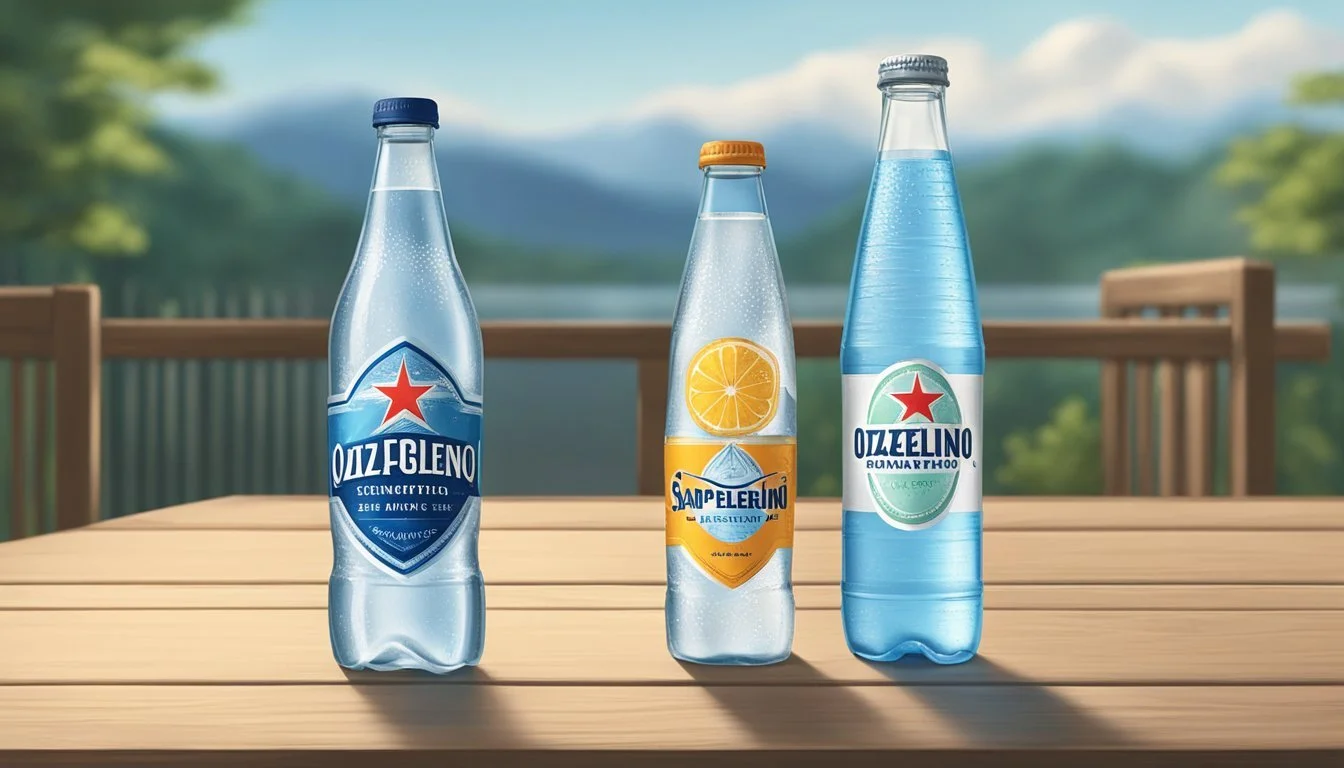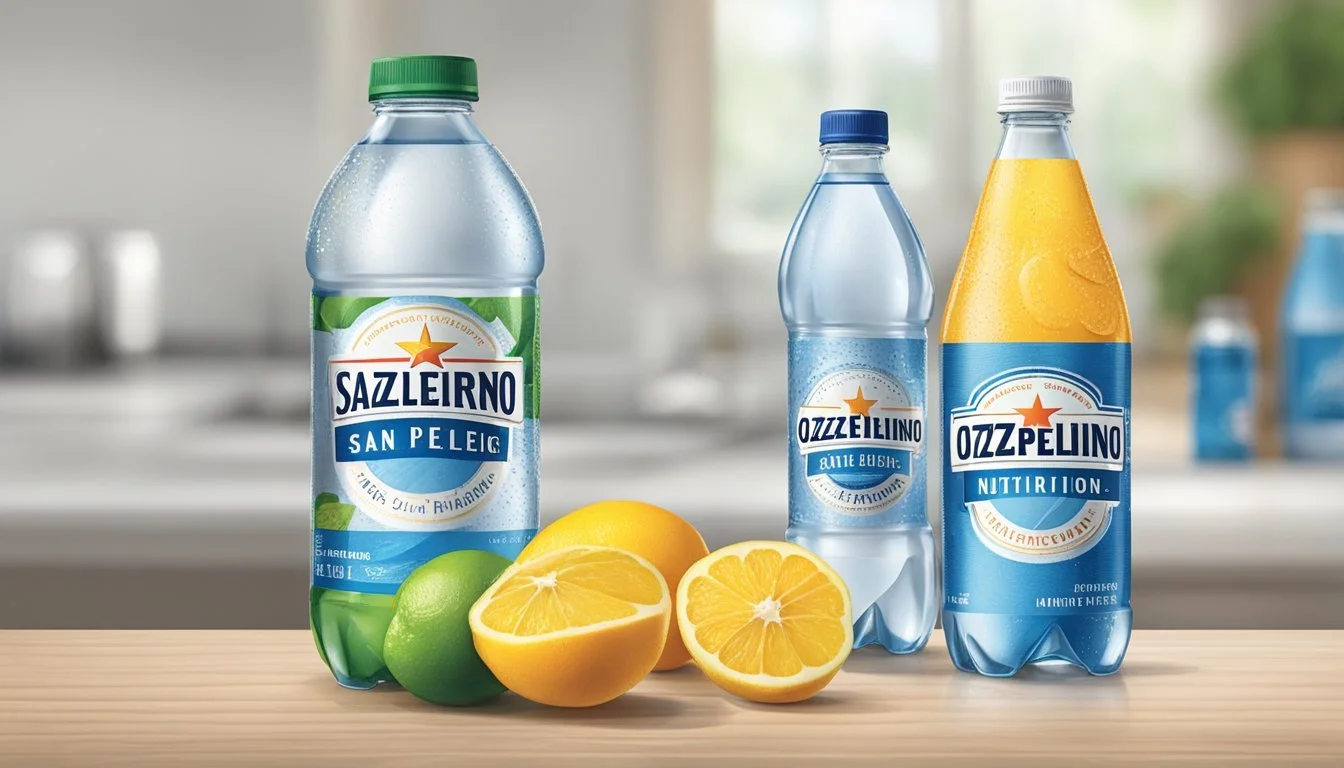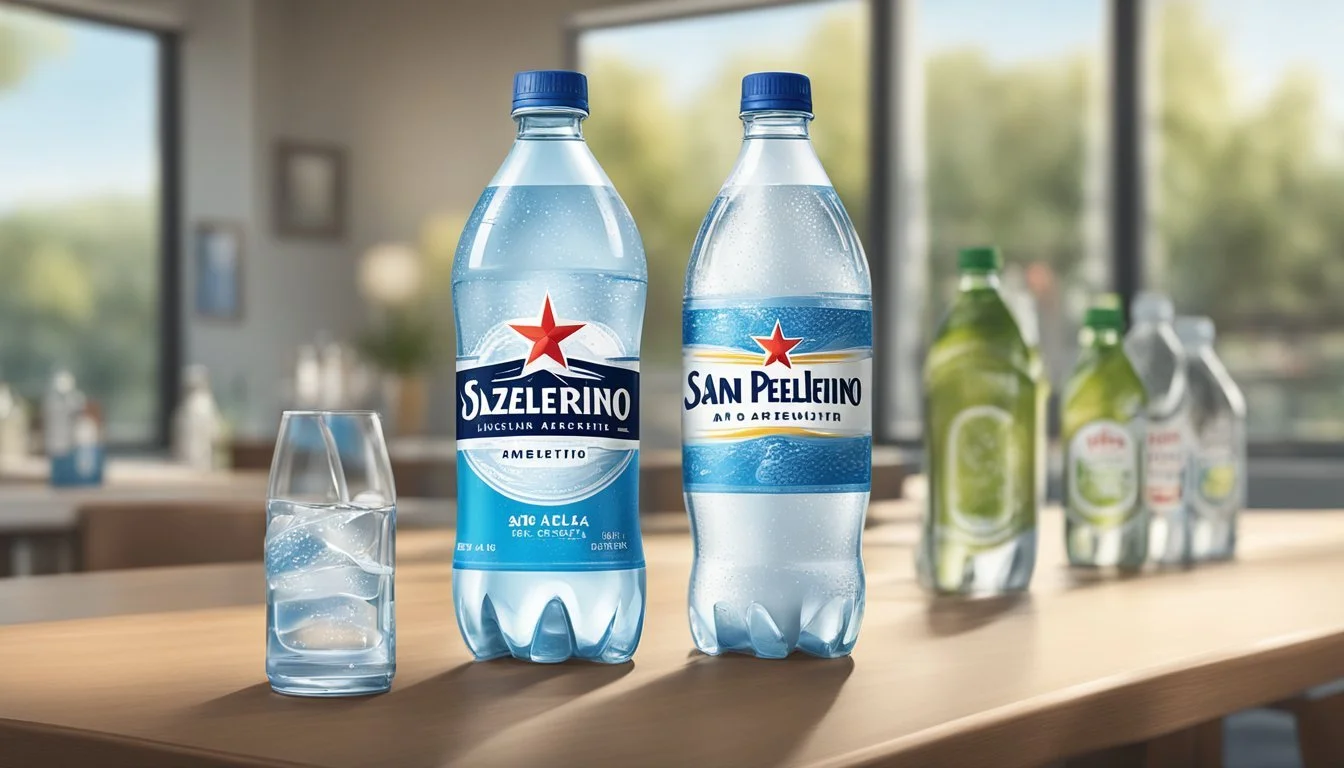Ozarka vs. San Pellegrino
Comparing Quality and Taste of Bottled Waters
When it comes to selecting bottled water, consumers are faced with a plethora of options, each claiming purity, taste, and mineral content superiority. Among these choices stand Ozarka and San Pellegrino, two brands with distinct origins and characteristics. Ozarka, sourced from natural springs in Texas, is known for its regional footprint and commitment to delivering straightforward hydration. On the other hand, San Pellegrino, an Italian brand with a global presence, is synonymous with its fine bubbles and status as a premium sparkling water, often associated with dining experiences.
The debate between the two brands isn't just about preference; it's also about understanding what each offers regarding quality, health benefits, and environmental impact. While Ozarka appeals to those seeking a non-carbonated, natural spring water with a clean taste, San Pellegrino caters to the sparkling water enthusiasts who enjoy a touch of elegance brought by its light effervescence and distinct mineral composition. Each brand's offering is certified and meets the bottled water standards, yet they cater to different market segments, with Ozarka focusing on accessibility and San Pellegrino emphasizing its luxurious appeal.
Analyzing Ozarka and San Pellegrino involves looking beyond marketing narratives and into aspects such as the presence of microplastics, water source sustainability, bottle material, and how these factors contribute to the overall product quality. Studies have pointed out the widespread issue of microplastics in bottled water, which is a concern for both consumers and environmentalists, making the examination of these brands not just a matter of taste but also a broader conversation on health and environmental stewardship.
Overview of Bottled Water
Bottled water has evolved significantly from its early days of being a niche product to becoming an everyday staple. This section will explore its historical context, the different types available, the trends influencing consumption, and the landscape of water brands today.
History of Bottled Water
The concept of bottled water is not a modern phenomenon; it traces its roots back centuries. In the 17th century, bottled spa waters were sold for their therapeutic benefits. By the 19th century, with the industrial revolution, the demand for bottled water grew due to the pollution of urban water supplies.
Types of Bottled Water
There are several types of bottled water, each distinguished by its source and treatment process:
Spring water: Originates from an underground formation and must flow naturally to the earth's surface.
Purified water: Has been processed to remove chemicals and contaminants.
Mineral water: Contains at least 250 parts per million of total dissolved solids (TDS), originating from a geologically and physically protected underground water source.
Sparkling water: Infused with carbon dioxide gas under pressure, it's also known as carbonated water.
Distilled water: Steam from boiling water is recondensed and bottled, removing impurities and minerals.
Current Trends in Bottled Water Consumption
In recent years, there has been a noticeable shift towards health-conscious and environmentally friendly drinking habits. Consumers are increasingly looking for:
Bottled waters with added health benefits, such as vitamins or electrolytes.
Eco-friendly packaging, with a push toward biodegradable materials or reusable containers.
Bottled Water Brands Landscape
The market is full of a diverse range of bottled water brands, each with its unique selling point. Some prominent water brands include:
Ozarka: Known for its natural spring water sourced from Texas springs.
San Pellegrino: Distinguished by its naturally occurring carbonation and mineral composition, often associated with fine dining.
Nestlé Pure Life: Affordable and widely distributed, with a rigorous purification process.
Aquafina: Purified drinking water that goes through a seven-step purification system.
Evian: A mineral water brand recognized for its balanced mineral content and origin from the French Alps.
As consumers navigate the bottled water market, they weigh factors such as taste, source, purity, and brand reputation.
Defining the Contenders
In the world of bottled waters, each brand offers its unique source and taste profile. Here, the focus is on two well-known contenders in the bottled water market: Ozarka and San Pellegrino, delving into the origins and characteristics that define them.
Profile of Ozarka
Ozarka is a brand of spring water that originates from natural springs in Texas, United States. This brand prides itself on delivering water drawn from three carefully selected spring sources located in the heartland of Texas. Ozarka's product range includes natural spring water, which is not only bottled directly from these sources, but also boasts of being free from added flavors or ingredients, ensuring a pure and refreshing taste.
Sources: Three natural springs in Texas
Product Range: Natural spring water
Features: No added flavors, 100% natural
Profile of San Pellegrino
San Pellegrino, on the other hand, is an Italian brand celebrated for its premium sparkling mineral water. The brand's source can be traced back to a natural spring in the Italian Alps, near the town of San Pellegrino Terme. San Pellegrino is renowned for its fine bubbles and balanced mineral content which provide a distinctive taste that's often preferred by gourmet enthusiasts.
Origin: Italian Alps
Product: Sparkling mineral water
Unique Traits: Fine bubbles, balanced mineral content, preferred by gourmands
Production Process
The production process of bottled water from brands like Ozarka and San Pellegrino entail distinct sourcing methodologies, advanced filtration and purification techniques, and different packaging approaches, which influence the final product's taste and quality.
Sourcing of Water
Ozarka: This brand sources its water from three springs located in Texas. It uses natural groundwater, which is collected with sustainability in mind, ensuring that the surrounding environment and water tables remain unaffected.
San Pellegrino: San Pellegrino's source is a spring in the Lombardy region of Italy. This brand is well-known for its premium sparkling water, which originates from alpine altitudes and is naturally imbued with minerals.
Filtration and Purification
Ozarka:
Filtration: Ozarka utilizes a multi-step filtration process.
Purification: It includes the use of ozone and ultraviolet light to ensure the water is free from impurities and microbes without affecting its natural mineral content.
San Pellegrino:
Filtration: The water naturally flows through alpine rock, where it is naturally filtered and gains minerals.
Purification: As a naturally occurring sparkling water, additional purification processes are minimal, preserving its characteristic mineral composition and carbonation.
Packaging Methodologies
Ozarka:
Plastic Bottles: Most commonly packaged in PET plastic bottles of various sizes.
Eco-friendly Practices: They have initiatives to reduce plastic use and commit to utilizing recycled materials.
San Pellegrino:
Glass: Primarily available in glass bottles, which is often preferred for maintaining the purity of taste for sparkling water.
Plastic Bottles: Also offers products in plastic bottles for convenience and wider distribution, with attention to recyclability.
Nutritional Composition
The nutritional quality of bottled water is often determined by its content of minerals and electrolytes, which are essential for hydration and various bodily functions.
Mineral Content Analysis
Ozarka and San Pellegrino waters are known for their distinct mineral profiles, which contribute to their taste and nutritional value. Ozarka water, sourced from springs in Texas, contains naturally occurring minerals like calcium, magnesium, and potassium, although the proportions may vary slightly depending on the source spring. San Pellegrino, on the other hand, is an Italian sparkling mineral water with a higher mineral content due to its journey through the Alpine limestone where it gathers electrolytes and beneficial minerals
Mineral Ozarka (mg/L) San Pellegrino (mg/L) Calcium 5-20 174 Magnesium 1-5 52 Sodium 10-15 33 Potassium 1-5 2.2 Bicarbonate 70-150 244
Understanding Electrolytes in Water
Electrolytes such as sodium, potassium, and magnesium in bottled water help conduct electrical impulses in the body. They are crucial for maintaining proper hydration, supporting nerve function, and regulating muscle contractions. Ozarka water provides a modest amount of electrolytes that may be ideal for regular hydration without the added fizz. San Pellegrino, with its carbonation, not only delivers effervescence but also a richer electrolyte profile, making it a suitable option for those looking to replenish electrolytes with a bolder taste.
Health Considerations
When comparing Ozarka and San Pellegrino bottled waters, consumers should consider hydration benefits alongside potential contaminants. They also need to be aware of how these products adhere to health standards enforced by regulatory bodies.
Hydration and Health
Hydration is crucial for maintaining health, and both Ozarka and San Pellegrino are effective in meeting the body's hydration needs. They provide the essential function of replenishing fluids lost through daily activities. However, the quality of the water can affect its overall health benefits.
Comparison of Contaminants
The presence of contaminants like PFAS chemicals, chloride, and chlorine can have implications for health. Research suggests that San Pellegrino had lower levels of microplastics compared to other brands, which is a promising sign. Although specific data on Ozarka was not mentioned, general studies underline the widespread issue of microplastics in various bottled water brands.
PFAS Chemicals:
San Pellegrino: Lower levels of microplastics
Ozarka: Not specified, general concern applies
Other Contaminants:
Chloride: Essential in small amounts; excess levels can lead to health issues
Chlorine: Used for disinfection; can be harmful in high concentrations
Regulations and Standards Enforcement
Both brands are subject to regulations by the Environmental Protection Agency (EPA) which sets quality standards for tap water, and bottled water must comply with Food and Drug Administration (FDA) regulations. The enforcement of these standards ensures both Ozarka and San Pellegrino meet minimum safety requirements, thus assuring consumers about the safety of their drinking water.
Taste Profile
When discerning the superiority of bottled water, taste profile is paramount. Ozarka and San Pellegrino waters offer distinct flavors shaped by their source and processing methods.
Factors Affecting Water Taste
The taste of water can be influenced by a myriad of factors, such as the water's source, the presence of minerals, and the level of carbonation. Ozarka, a brand known for its natural spring water from Texas, boasts a flavor that's often described as fresh and clean due to its natural filtration process. San Pellegrino, on the other hand, is a sparkling mineral water sourced from the Italian Alps and is renowned for its crisp taste combined with fine bubbles of carbonation.
Role of Minerality in Taste
Minerality plays a crucial role in the taste of bottled water. It refers to the amount and type of minerals found in the water, which can significantly affect the flavor. Ozarka water contains minerals like calcium, magnesium, and potassium, which contribute to its smooth and balanced taste. San Pellegrino is rich in minerals such as calcium, chloride, and sulfate, and also contains higher levels of carbonation, providing a slightly salty yet pleasingly bitter taste, often preferred by consumers for its distinct palate sensation.
Mineral Content Comparison:
Ozarka: Balanced mineral composition.
San Pellegrino: High mineral content with signature fizz.
Perception of Taste: A Sommelier's View
Taste is subjective and can vary widely from person to person, but sommeliers can offer expert insight into the nuances of water taste. They may evaluate bottled water similarly to wine, observing its mouthfeel, flavor complexity, and finish. A sommelier might note that San Pellegrino's fine carbonation provides a sharp mouthfeel that enhances its minerality, while Ozarka's lack of bubbles and natural essence creates a smoother drinking experience. A hint of natural flavors such as lime can influence individual perception, making the taste profile of each brand uniquely appealing to different palates.
Environmental Impact
When comparing Ozarka and San Pellegrino, one must consider the environmental ramifications associated with bottled water production, especially in terms of plastic waste and carbon footprint.
Plastic Waste and Recycling
Ozarka and San Pellegrino bottles contribute to plastic waste, a significant environmental concern. Ozarka, predominantly packaged in PET plastic bottles, is part of a recycling program where the bottles are 100% recyclable. San Pellegrino, often recognized by its green glass bottles, also provides recyclable packaging, though the recycling rates for glass are typically lower than for PET plastics.
Ozarka:
Packaging: PET plastic (Polyethylene Terephthalate)
Recyclability: 100% recyclable
San Pellegrino:
Packaging: Glass
Recyclability: Lower recycling rates compared to PET
The effectiveness of these recycling efforts is contingent upon consumer behavior and local recycling infrastructure.
Carbon Footprint of Bottled Water
Transportation and manufacturing of bottled water are key contributors to its carbon footprint. The carbon footprint of bottled water from brands like Ozarka and San Pellegrino includes extraction, bottling, and distribution. Water sourced locally, such as Ozarka from Texas, may have a lower transportation footprint for regional consumers compared to San Pellegrino, which is sourced from Italy and imported.
Ozarka:
Sources: Texas
Transport Footprint: Potentially lower for regional distribution
San Pellegrino:
Sources: Italy
Transport Footprint: Higher due to international shipping
These aspects underscore the environmental impact each bottled water brand holds, influencing a consumer's environmentally conscious choice.
Consumer Preferences
When selecting bottled water, consumers weigh factors such as brand reputation, taste, and price. These preferences play a significant role in their purchasing decisions.
Brand Loyalty and Consumer Choices
Consumers often exhibit a strong sense of brand loyalty when it comes to bottled water. Ozarka's followers praise its natural sourcing from Texas springs and its regional identity, which resonates with a sense of local pride. On the other hand, San Pellegrino's audience appreciates the brand's Italian heritage and distinctive mineral taste, which is often associated with fine dining and sophistication. This loyalty sometimes causes consumers to choose a particular brand regardless of price differences, as the perceived value lies not just in the product but in the brand's image and its alignment with the consumer's self-identity.
Price Sensitivity and Value Perception
Price plays a crucial role in consumer preferences, especially for everyday purchases like bottled water. Ozarka, generally positioned as a cost-effective option, appeals to consumers who are sensitive to price yet still value the taste and quality of their water. San Pellegrino, with a higher price point, is often perceived as a premium product, which influences some buyers to perceive it as offering greater value due to its luxury connotation. Consumers weigh the price against the perceived benefits, such as taste and brand prestige, to determine the overall value proposition of their bottled water choice.
Both brands reinforce their value propositions through packaging and marketing, with Ozarka emphasizing its local sourcing and affordability, and San Pellegrino its international reputation for high-quality, mineral-enriched water.
Market Competition
In the competitive landscape of bottled water, Ozarka and San Pellegrino hold distinct positions with various alternatives vying for market share, each offering unique selling propositions.
Head-to-Head Brand Analysis
Ozarka, a brand known for its natural spring water sources in Texas, caters primarily to a regional market. It emphasizes its local origin and natural filtration, appealing to consumers who prefer spring water with a regional identity. San Pellegrino, an Italian brand recognized globally, stands out with its signature sparkling mineral water. It appeals to those who appreciate a more upscale product, often found in restaurants and hotels.
Competing brands like Dasani and Aquafina, backed by Coca-Cola and PepsiCo respectively, dominate the purified water segment through extensive distribution networks. Evian and Fiji are comparable to San Pellegrino, placing themselves as premium selections, with the former highlighting its French alpine source and the latter its tropical origin.
Core Hydration and SmartWater offer enhanced waters, targeting health-conscious consumers. Whereas regional brands such as Deer Park and Zephyrhills resonate with local markets akin to Ozarka. Arrowhead is known for its mountain spring sources in the west, much like the waters hailing from Texas.
Alternative Brands and Substitutes
The market for bottled water also includes an array of niche and specialty waters. Icelandic Glacial, as an example, markets the purity of Iceland's resources, competing on geographic distinction. Acqua Panna, tied with San Pellegrino under the Nestlé umbrella, provides still mineral water, contrasting San Pellegrino's carbonation.
Other brands offering varied taste and experience include La Croix, popular for its flavored sparkling waters; Voss, which emphasizes Norwegian purity and bottle design; and Mountain Valley Spring Water, known for its mid-American spring source. Life WTR presents itself as a premium purified water, with a focus on pH balance and artistic packaging.
Eco-conscious choices like Boxed Water, Eternal Water, and Ethos Water attract those looking to minimize their environmental impact, while sparkling water enthusiasts have options such as Spindrift, Polar, Topo Chico, and San Pellegrino's own line of flavored sparkling beverages. With numerous players in the field, competition is fierce, and brands continually strive to differentiate themselves through their source, taste, environmental impact, and health benefits.
Conclusion
In evaluating Ozarka and San Pellegrino, one must account for their sources, mineral content and personal preferences related to taste and utility.
Final Thoughts on Ozarka and San Pellegrino
Ozarka is a natural spring water sourced from Texas springs, offering a smooth taste and a moderate mineral content that makes it suitable for daily hydration needs. San Pellegrino, on the other hand, is an Italian sparkling mineral water known for its fine bubbles and distinctive mineral taste due to its high mineral content. San Pellegrino may also serve as a palate cleanser or a sophisticated non-alcoholic beverage option.
Recommendations for Consumers
When choosing between Ozarka and San Pellegrino, consumers should consider the following:
Purpose: Ozarka may be preferred for regular hydration, while San Pellegrino could be the choice for dining occasions and those preferring sparkling water.
Mineral Content: Individuals with specific dietary needs related to mineral intake should review the labels, as San Pellegrino has higher mineralization.
Taste Preference: Some might prefer the crisp, refreshing nature of non-carbonated Ozarka, whereas others may favor the zesty kick that the effervescence of San Pellegrino provides.
Ultimately, the decision lies with personal preference and the intended use of the bottled water.







